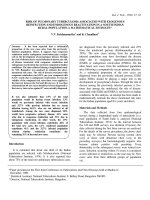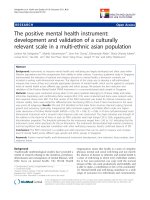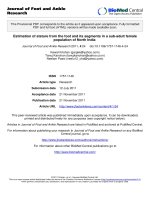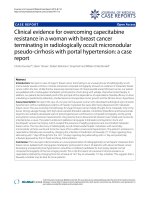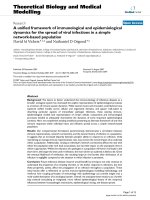Genetics of shoot fly resistance in a recombinant inbreed lines population of sorghum [Sorghum bicolor (L.) Moench]
Bạn đang xem bản rút gọn của tài liệu. Xem và tải ngay bản đầy đủ của tài liệu tại đây (217.88 KB, 10 trang )
Int.J.Curr.Microbiol.App.Sci (2019) 8(3): 2603-2612
International Journal of Current Microbiology and Applied Sciences
ISSN: 2319-7706 Volume 8 Number 03 (2019)
Journal homepage:
Original Research Article
/>
Genetics of Shoot Fly Resistance in a Recombinant Inbreed Lines
Population of Sorghum [Sorghum bicolor (L.) Moench]
S.P. Mehtre1, C.T. Hash2, H.C. Sharma2, S.P. Deshpande2 and G.W. Narkhede1*
1
Vasantrao Naik Marathwada Krishi Vidyapeeth, Parbhani 431 402 (MS) India
2
International Crops Research Institute for the Semi-Arid Tropics (ICRISAT),
Patancheru, 502324, Telangana India
*Corresponding author
ABSTRACT
Keywords
Shoot fly,
Atherigona soccata,
Recombinant inbred
lines (RILs),
Glossiness,
Trichome density,
Genetics
Article Info
Accepted:
26 February 2019
Available Online:
10 March 2019
Sorghum shoot fly [Atherigona soccata (Rondani)] is one of the most important pests of
grain sorghum. It is important to understand the nature of gene action to breed for
resistance to the target insect pest. In the present study, a population of 259 sorghum
recombinant inbred lines (RILs) derived from cross 296B (shoot fly susceptible) x IS
18551 (shoot fly resistant) were evaluated in shoot fly screening nursery to study the
inheritance of shoot fly resistance. Variances due to RIL genotypes (G), screening
environment (E) and G x E interactions were significant for the traits studied. Normal
distribution of RIL means suggested quantitative inheritance of trait studied. Heritability
(broad sense) estimates for glossiness intensity, oviposition incidence (%) and dead hearts
incidence (%) were consistent in individual and low across environment analyses
indicating that, these traits can be used as reliable parameters to select a plant with
resistance to shoot fly. High broad sense heritability estimates were recorded for trichome
densities (on both upper and lower leaf blades), but exhibited significant G x E
interactions. Transgressive sergeants with phenotypic values outside the parental limits
were observed for oviposition (%), dead heart (%) and trichome density. Utilization of
RILs 46, 208, 222 and 223 (kharif season adaptation) and RILs 47, 51, 82, 97, 130 and 174
(rabi season adaptation) which exhibited shoot fly resistance combined with better
agronomic feature will be useful in sorghum shoot fly resistance breeding.
Introduction
Sorghum [Sorghum bicolor (L.) Moench] is
the fifth most important cereal crop worldwide
(FAO STAT 2004) and an important rainfed
cereal crop in the semi-arid tropics (SAT).
India is the major producer of sorghum with
the crop occupying 9.9 million hectares with
an annual production of 8.0 million metric
tones during 2003-2004 (FAS 2005). Genetic
manipulation of sorghum in India since the
1960s has led to the development of several
high yielding varieties and hybrids. However,
many of these were highly susceptible to shoot
fly [Antherigona soccata (Rondani)] which
often resulted in severe damage to the crop
(Rao and Rao, 1956; Jotwani and Srivastava,
1970). Adoption of chemical control is not
2603
Int.J.Curr.Microbiol.App.Sci (2019) 8(3): 2603-2612
economically feasible for resource-poor
farmers of the semi-arid tropics (SAT), as the
low crop value per acre precludes the use of
insecticides for control of shoot fly (Dhamas,
1943). Therefore host plant resistance
combined with non-monitory input like timely
sowing is the most realistic approach to
minimize grain and stover yield losses.
Blum (1967) observed that resistance to shoot
fly in sorghum is due to ovipositional nonreference, which becomes ineffective when
shoot fly populations are high (Jotwani and
Srivastava, 1970). Glossy leaves (Agrawal and
House, 1982), seedling vigor (Jadhav et al.,
1986) and trichomes on the abaxial leaf blade
(Mati and Bidiger, 1979) are reported to be the
main factors responsible to shoot fly
resistance.
The selection of shoot fly resistant sorghum
genotypes by utilizing any one of the above
resistance factors is inefficient due to several
components involved in imparting resistance.
Moreover each of these factors are governed
by one or more genes and exhibit considerable
genotype (G) x environment (E) interaction.
Genetic analysis of quantitative traits requires
replicated multi-environment testing because
of the un-replicability of field screening
environments and possible
G x E
interactions. This can be accomplished by
using a population of recombinant inbred lines
(RILs), as it constitutes a permanent seed
source of multiple field screenings (Burr et al.,
1988) and as each genotype in the RIL
population is represented by a progeny, rather
than by an individual a more accurate
assessment of the genetic component of
variance can be made in studying the
quantitative traits. Hence, the present study
was undertaken to study the genetic
architecture of shoot fly resistance under
varying levels of shoot fly infestation by using
a sorghum RIL populations.
Materials and Methods
Studies on the genetics of shoot fly resistance
in a sorghum RIL population were conducted
in two screening environments at International
Crops Research Institute for the Semi-Arid
Tropics (ICRISAT), Patancheru, India during
late kharif (sown on 16th August 2002) and
early rabi (sown on 16th October 2004)
season. The experimental material consisted of
a set of 259 F7 RILS derived from a cross
between two sorghum inbred lines viz. 296B
(derived from Aispuri and susceptible to shoot
fly) and IS 18551 (originating from Ethiopia
and resistant to shoot fly). After the initial
cross between 296 B and IS 18551, a single F1
plant was selfed and the resulting F2 seeds
were sown to produce F2 plants. Selfing of F2
plants produced F3 seeds, which were sown
head to row. Each F3 plant was selfed and
from each head-to-row plot, a single plant
randomly chosen to provide seeds for the next
generation. This modified single seed descent
method, where each line was advanced using a
single randomly selected plant, was repeated
for 3 to 4 generations. Recommended
protections measures were taken during RIL
population development at ICRISAT to
minimize selection for shoot fly resistance.
Each of the resulting 259 F7 lines represented
the single F2 plant from which it is derived.
Screening of the RIL for shoot fly resistance
was carried out at the ICRISAT, Patancheru,
Andhra Pradesh, India. A total of 300 lines
(259 RILs +14 times repeated checks of each
of 296B and IS18551) and a standard check,
CSH-9, repeated 13 times) were sown on 16th
August during 2002 kharif season (E1), for
early rabi season (E2), a total of 270 entries
(259 RILs + 4 times repeated checks of each
of 296B and IS18551 + standard check CSH 9
repeated 3 times), were sown on 16th October
2004. The test material was planted in
balanced design, with 75 cm and 15 cm inter
and intra-row spacing respectively. In the late
kharif and rabi seasons, each entry was grown
in two-row plot of 2 m length in four and three
2604
Int.J.Curr.Microbiol.App.Sci (2019) 8(3): 2603-2612
replications respectively. Shoot fly infestation
was quite high during the kharif season.
During the rabi season, the shoot fly
infestation was relatively low to ensure
uniform and optimum shoot fly infestation
under field condition. The interlard fish meal
technique (Sharma et al., 1992) was followed
to screen for resistance to shoot fly.
Observations on glossiness were recorded at 7
days after emergence (DAE) scored visually 1
to 5 scale (1 = highly glossy and 5 =
uniformly non-glossy). The leaf glossiness
score was recorded before thinning at 7 DAE,
and plant counts per plot were taken the next
day. Oviposition counts were taken at 14 DAE
(I) and 21 DAE (II) and oviposition incidence
was recorded as the percentage of plants with
eggs. While dead hearts counts were taken at
21 DAE (I) and 28 DAE (II) and dead heart
incidence was recorded as a percentage of
plants with dead hearts. Trichome density on
the central portion of the fifth leaf from the
base was recorded (no. of trichome per
microscopic field on upper and lower leaf
blades) at 17 DAE in both screening
environments. Agronomic traits such as time
to 50% flowering (days), plant height (cm)
and grain yield (gm2) were also recorded.
The analysis of variance for phenotypic data
sets were performed using the residual
maximum likelihood algorithm (REML),
which estimates the components of variance
by maximizing the likelihood of all contrasts
with zero expectation (Paterson and
Thompson 1971) and provides best linear
unbiased predictions (BLUPs) of the
performance of the genotypes. For each trait
and for each entry, the predicted means were
calculated with replications as fixed effects
and entries with replication x block as a
random
effect
for
both
individual
environments (seasons). For across screening
environment (seasons) analyses, environment
and replications were treated as fixed effect
and entries, environment x entries, and
environment x replication interactions as
random effects. The data was analyzed using
the Genestat (6th edition) software package
(Payne 2002).
Results and Discussion
The mean performance of the two parents
(296B and IS18551) revealed significant
phenotypic differences (Table 1) for shoot fly
resistance and other agronomic traits except
for time to 50% flowering (days) in kharif and
grain yield in rabi. Parental performance
under different environments varied for all the
traits except for glossiness. For glossiness
intensity, the parental and RIL mean
performances were consistent across the two
seasons. Similar observations have been
reported by Jayanthi et al., (1999). Parental
mean values and RIL ranges for oviposition I,
II and dead hearts I, II indicated greater shoot
fly pressure in kharif than in the rabi
screening environment. The range of the RIL
mean values for oviposition and dead hearts
incidence clearly indicated that shoot fly
population pressure in both screening
environment was high to optimal as it allowed
expression of a wide range of phenotypic
values. Borikar et al., (1982) observed higher
variability when the material was tested under
optimum shoot fly population levels. While
Rana et al., (1975) reported that selection for
shoot fly resistance was effective under
conditions when morality ranged from 7 to
67%.
Trichome density was quite consistent across
seasons but was greater in rabi season than to
kharif season and greater on upper leaf blade
than on lower leaf blade. Similar observations
were revealed by Mati and Gibson (1983),
Borikar and Chundurwar (1989) and Sajjanar
(2002). Elite shoot fly susceptible parent 296B
was late in flowering, shorter in height and
lower yielding than IS18551 in both the
screening environments, although some of the
differences observed may have been due to the
confounding
influence
of
differential
2605
Int.J.Curr.Microbiol.App.Sci (2019) 8(3): 2603-2612
susceptibility to shoot fly. The wide variation
observed in the RIL population for glossiness
intensity, oviposition, dead heart incidence,
and trichome density indicated that the
population can be used to map quantitative
trait loci (QTLs) governing these traits,
provided that sufficient marker polymorphism
can be detected between the parents to track,
genome-wide segregation patterns.
The genotypic variances for glossiness,
oviposition I, II, dead heart I, II, trichome
density (upper and lower leaf blades), time to
50% flowering, plant height and grain yield
were greater than the corresponding variances
for G x E interaction (Table 2) indicating that
these traits are under genetic control although
G x E interactions had significant influence on
in their expression. Similar results have been
reported by Jayanthi et al., (1999), and the
differential response of sorghum genotypes to
variation in photoperiod, measured in terms of
flowering time and plant height is well known.
Components traits associated with shoot fly
resistance showed low to moderate broad
sense heritability estimates (Table 3).
Consistently high heritability estimates were
observed for glossiness in two individual
screening environments and moderate
estimates across these two test environment
indicated that contributions to phenotypic
variance due to environmental factors and G x
E interaction are less than, genotype factors as
evident from values of genotype and G x E
variances. The G x E variance component is,
however significant indicating the complex
nature of glossiness. Agrawal and Abranam
(1985) indicated that the seedling glossiness
intensity is quantitative in nature and
controlled by both additive and non-additive
genes. Oviposition and dead heart incidence
recorded, low to moderate but consistent
operational heritability estimates in the two
individual screening environments and also at
different stages of observation. However,
operational heritability estimates for these
traits across seasons for both observation
stages were low indicating a prominent role of
screening environment and/or genotype x
environment interaction in the expression of
the trait. This observation corroborates by
Halalli et al., (1983), Borikar and Chopde
(1982) and Borikar et al., (1982).
Consistently high heritability estimates were
recorded in both screening environments for
trichome density on upper and lower leaf
blades, while across season analyses revealed
lower heritability estimates for trichome
densities of both leaf blades (h2 = 0.51 for
upper and h2=0.49 for lower leaf blade). This
indicates the role of environmental factors and
G x E factor in the expression of this trait. The
result obtained in this study reveals that there
are strong seasonal effects on the expression
of trichome density. These results are in
agreement with those of Jayanthi et al., (1999)
and Sajjanar (2002).
The analysis revealed that RIL means differed
significantly from both the parents to shoot fly
resistance traits (Table 4). Transgressive
sergeants with phenotypic values outside the
parental limits were observed for most of the
shoot fly resistant traits except for leaf
glossiness. For oviposition, I, II, dead heart I,
II and grain yield, the RIL population mean
was less than the mid-parental value. In
contrast to glossiness, the trichome density
(both on upper and lower leaf blades) and
plant height, RIL population mean values
were greater than the mid-parental value. In
general, the proportion of RIL outside the
parental limits was greater for those outside
the low-scoring parents and lower for outside
high scoring parents. The expectation of equal
frequencies of inbreeds lying outside the limits
of either parent was not observed in any case.
This shows that, for shoot fly resistance and
its component traits, there were epistatic
interactions (predominance of additive x
additive gene action) influencing trait
expression in this RIL population.
2606
Int.J.Curr.Microbiol.App.Sci (2019) 8(3): 2603-2612
Table.1 Mean, the standard error for two parents and mean, the range of RILs derived from 296B × IS 18551 mapping population for
different components of resistance to shoot fly and agronomic traits in two screening environments at ICRISAT,
Patancheru during 2002 – 04
Character
E1 (kharif) Patancheru
P1
(296B)
P2
SE +
(IS 18551)
RIL
mean
E2 (rabi) Patancheru
Range
P1
(296B)
P2
SE +
(IS 18551)
RIL
mean
Range
Glossiness Intensity (scale)
5.0**
1.0**
0.26
3.6
1.0-5.0
5.0**
1.1**
0.35
3.5
1.3-5.0
Oviposition I (%)
68.7**
45.0**
5.71
61.2
41.0-81.0
55.2**
15.5**
7.4
35.0
0.0-72.6
Oviposition II (%)
95.5**
79.0**
3.42
89.7
75.1-99.2
81.2**
33.1**
6.6
57.8
16.7-90.7
Deadhearts I (%)
75.7**
51.5**
3.73
73.3
53.0-85.0
60.0**
17.0**
7.6
35.1
5.6-76.0
Deadhearts II (%)
96.0**
68.5**
2.45
87.7
69.0-97.0
77.4**
25.8**
6.6
50.6
25.9-83.6
Trichome density upper leaf 0.0**
blade (no./microscopic field)
152.2**
6.70
80.6
0.0-213.0
0.0**
189.7**
7.9
87.3
0.0-240.0
Trichome density lower leaf 0.0**
blade (no./microscopic field)
73.0**
3.86
32.0
0.0-92.7
0.0**
83.1**
4.9
43.7
0.0-137.7
Time to 50% flowering (days) 89.4
87.8
2.00
83.4
67.0-97.0
82.0**
75.00**
1.8
72.8
61.0-84.0
Plant height (cm)
110.5**
244.0**
8.94
194.6
118-284
105.0**
161.5**
7.7
165.9
100-218
Grain yield (gm/plot)
194.0**
1074.0**
100.0
519.1
87-1120
393.0
539.00
110
479.0
56-1018
2607
Int.J.Curr.Microbiol.App.Sci (2019) 8(3): 2603-2612
Table.2 Genotype variances, GXE interaction and respective standard errors for components of resistance to shoot fly and other traits
in sorghum RIL mapping population derived from cross 296B × IS 18551 under individual and across season screening environment
Sr. Character
No.
E 1 (late kharif)
62g
SE+
E 2 (rabi)
62g
SE+
E1-E2 (across season)
62g
SE+
62gxe
SE+
1.
Glossiness intensity
3.08**
0.27 3.21**
0.35
4.6**
0.21 1.7**
0.34
2.
Oviposition I (%)
166.2**
5.7
493.5**
7.4
363.2**
4.5
299.8**
7.2
3.
Oviposition II (%)
75.1**
3.4
432.3**
6.6
255.8**
3.4
250.7**
5.2
4.
Deadhearts I (%)
144.6**
3.7
856.2**
7.6
330.2**
3.8
274.1**
5.9
5.
Deadhearts II (%)
99.4**
2.5
410.8**
6.6
266.8**
3.1
242.6**
4.8
6.
Trichome density upper leaf blade 11309.1**
(no./microscopic field)
4.8
8685.9** 8.10
13317.7**
4.6
6571.2** 7.10
7.
Trichome density lower leaf blade 2064.5**
(no./microscopic field)
2.9
2615.7** 4.9
3092.1**
2.7
1583.8** 4.10
8.
Time to 50% flowering (days)
129.1**
2.1
68.3**
141.4**
1.5
56.9**
2.30
9.
Plant height (cm)
4362.2**
9.1
1263.4** 6.9
4927.5**
6.6
793.6**
10.4
10.
Grain yield (gm/plot)
160726.0** 99.0 7563.0** 190.0 152599**
2608
1.8
73.7 83873**
115.3
Int.J.Curr.Microbiol.App.Sci (2019) 8(3): 2603-2612
Table.3 Operational heritability estimates (broad sense entry mean basis) for components of resistance to shoot fly and other traits in
sorghum RIL population derived from cross 296B x IS18551 evaluated under two screening environments and across environments at
Patancheru
Character
E1
E2
E1 E2
(kharif, Patancheru)
(rabi, Patancheru)
(across seasons)
Glossiness intensity (scale)
0.90
0.88
0.64
Oviposition I (%)
0.20
0.67
0.17
Oviposition II (%)
0.38
0.70
0.02
Deadhearts I (%)
0.62
0.63
0.17
Deadhearts II (%)
0.74
0.68
0.09
Trichome density upper leaf blade (no./microscopic
field)
0.98
0.98
0.51
Trichome density lower leaf blade (no./microscopic field)
0.97
0.97
0.49
Time to 50% flowering (days)
0.87
0.85
0.60
Plant height (cm)
0.91
0.86
0.84
Grain yield (gm/plot)
0.75
0.53
0.45
2609
Int.J.Curr.Microbiol.App.Sci (2019) 8(3): 2603-2612
Table.4 Means of parents, the RIL population, their difference and proportion of RILs with values outside the parental limits based on
pooled means over two screening environments
Character
P1
296B
P2
IS
18551
Midparent
al
value
RIL
populatio
n
mean
Test of
significance
of means
P1/RI P2/RIL
L
**
**
Glossiness intensity (scale)
5.0
1.1
3.0
3.6
Oviposition I (%)
66.3
40.9
53.6
49.9
**
Oviposition II (%)
93.0
72.6
82.8
76.1
Deadhearts I (%)
72.9
46.8
59.9
Deadhearts II (%)
92.6
62.6
0.0
Proportions
outside the
parental limits
P2
P1
0.000
0.000
**
0.015
0.092
**
ns
0.003
0.281
56.9
**
**
0.015
0.054
77.6
71.8
**
**
0.000
0.057
157.4
78.7
83.6
**
**
0.000
0.042
0.0
74.4
37.2
37.7
**
**
0.000
0.039
Plant height (cm)
109.5
232.3
170.9
182.3
**
**
0.000
0.015
Grain yield (g/plot)
228.7
999.6
614.2
502.1
**
**
0.027
0.000
Trichome density upper leaf
blade (no./microscopic field)
Trichome density lower leaf
blade (no./microscopic field)
2610
Int.J.Curr.Microbiol.App.Sci (2019) 8(3): 2603-2612
The further occurrence of transgressive
segregants indicates that both parental lines of
the RIL population carried both desirable and
undesirable alleles at various loci governing
the traits. These results are in agreement with
Borikar and Chopde (1981). Continuous
distribution for shoot fly resistance traits
revealed their quantitative inheritance.
Considering the complex nature of shoot fly
resistance revealed by the present study,
direct transfer of shoot fly resistance from
donor IS 18551 to an elite background such as
296B will probably require many cycles of
crossing and selection. Therefore utilization
of agronomically desirable RILS 46, 208, 222
and 223 (kharif season adoption) and RILS
47, 51, 82, 97, 130 and 174 (rabi season
adoption) in shoot fly resistance breeding is
likely to be more fruitful than direct use of an
agronomically deficient source like IS18551.
References
Agrawal, B.L. and C.V. Abraham. 1985.
Breeding sorghum for resistance to
shoot fly [Atherigona soccata] and
midge
[Contarinia
sorghicola].
Proceedings of the International
Sorghum Entomology Workshop, 1521 July 1984, Texas A & M
University, College Station, TX, USA,
pp. 371-383.
Agrawal, B.L. and L.R. House. 1982.
Breeding for pest resistance in
sorghum. In: Sorghum in the Eighties,
Proceedings of the International
Symposium
on
Sorghum,
2-7
November 1981, International Crops
Research Institute for the Semi-Arid
Tropics, Patancheru, AP, India,
pp.435-446.
Blum, A. 1967. Varietal resistance of
sorghum to the sorghum shoot fly
[Atherigona varia soccata]. Crop Sci.
7: 461-462.
Borikar, S.T. and P.R. Chopde. 1981. Shoot
fly resistance in sorghum. Indian J.
Genet. 41: 191-199.
Borikar, S.T. and P.R. Chopde. 1982.
Genetics of resistance to sorghum
shoot fly. Z. Pflanzenzüchtg, 88: 220224.
Borikar, S.T. and R.D. Chundurwar. 1989.
Genetic analysis for trichome density
in Sorghum bicolor (L.) Moench. J.
Maharashtra Agric. Univ. 14: 304305.
Borikar, S.T., R.D. Chundurwar and P.R.
Chopde. 1982. Genetic variability for
shoot fly resistance in sorghum. J.
Maharashtra Agric. Univ. 7: 223-225.
Burr, B., F.A. Burr, K.H. Thomson, M.C.
Albertson and C.W. Stubber. 1988.
Gene mapping with recombinant
inbreds in maize. Genetics, 118: 518526.
Dhams, R.G. 1943. Insect resistance in
sorghum and cotton. Amer. Soc.
Agron. J. 35: 704-715.
FAOSTAT. 2004. />htm
FAS. 2005. FAS Online.
United
States
Department
of
Agriculture, Foreign Agricultural
Service.
Halalli, M.S., B.T.S. Gowda, K.A. Kulkarni
and J.V. Goud. 1983. Evaluation of
advanced generations progenies for
resistance to shoot fly in sorghum.
Indian J. Genet. 43: 291-293.
Jadhav, S.S., U.N. Mote and D.R.
Bapat.1986.
Biophysical
plant
characters contributing to shoot fly
resistance. Sorghum Newslett. 29: 70.
Jayanthi, P.D.K., B.V.S. Reddy, T.B. Gour
and D.D.R. Reddy. 1999. Genetics of
glossy and trichome characters in
sorghum hybrids of cytoplasmic male
sterile lines. J. Maharashtra Agric.
Univ. 24: 251-256.
Jotwani, M.G., K.K. Marwaha, K.M.
Srivastava and W.R. Young. 1970.
2611
Int.J.Curr.Microbiol.App.Sci (2019) 8(3): 2603-2612
Seasonal incidence of shoot fly
(Atherigona soccata Rond.) in jowar
hybrids at Delhi. Indian J. Ent. 32: 715.
Maiti, R.K. and F.R. Bidinger. 1979. A
simple approach to identification of
shoot fly resistance in sorghum. Indian
J. Pl. Protec. 7: 135-140.
Maiti, R.K. and P.T. Gibson. 1983. Trichomes
in segregating generations of sorghum
matings. II. Association with shoot fly
resistance. Crop Sci. 23: 76-79.
Paterson, H.D. and R. Thompson.1971.
Recovery of inter-block information
when block sizes are unequal.
Biometrika, 58: 545-554.
Payne, R.W. (Ed.) 2002. The Guide to
Genestat® Release 6.1. Part 2:
Statistics. VSN International Ltd.,
Oxford, U.K.
Rana, B.S., D.P. Tripathi, K. Balakotaiah, R.
Damodar and N.G.P. Rao. 1975.
Genetic analysis of some exotic
Indian crosses in sorghum XI.
Selection for shoot fly resistance.
Indian J. Genet. 35: 350-354.
Sajjanar, G.M. 2002. Genetic analysis and
molecular mapping of components of
resistance to shoot fly (Atherigona
soccata) in sorghum [Sorghum bicolor
(L.)
Moench.].
Ph.D.
Thesis,
University of Agricultural Sciences,
Dharwad.
How to cite this article:
Mane, P.N., Manjusha S. Gaikwad, Prerna B. Chikte and Makarand P. Shinde. 2019. Integrated
Management
of
Alternaria
Leaf
Blight
and
Necrosis
of
Sunflower.
Int.J.Curr.Microbiol.App.Sci. 8(03): 2603-2612. doi: />
2612
